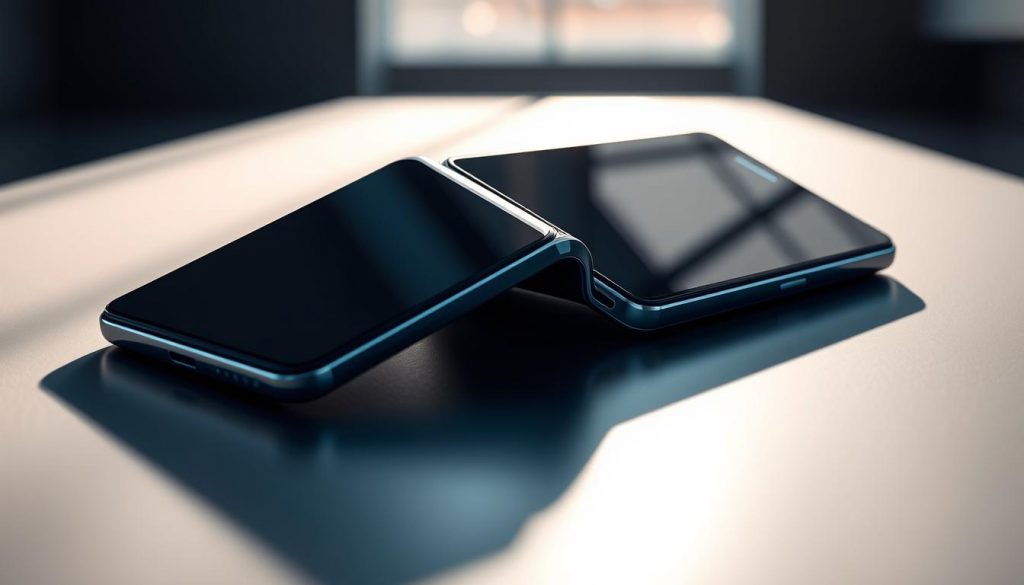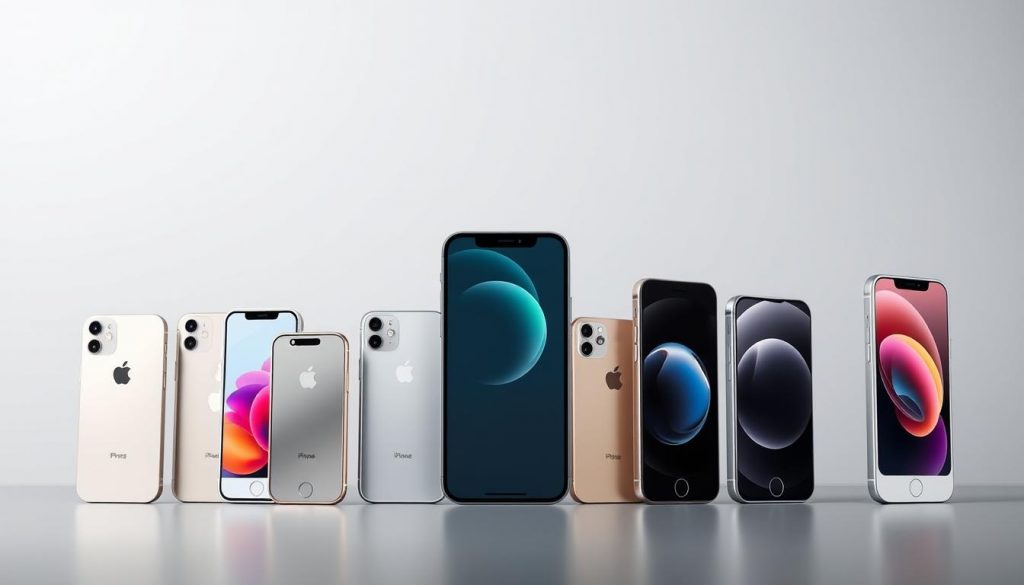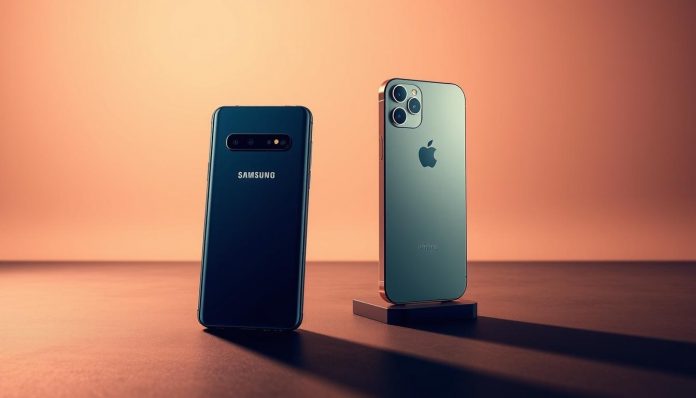One striking stat: within hours of a major product reveal, a rival company took to global media channels to challenge the narrative, turning a single keynote into a worldwide technology flashpoint.
The UK felt this as a clear news moment. The Apple showcase on 9 September introduced an exceptionally thin handset with upgraded intelligence and next‑generation connectivity. That mix of design and technical gains made the launch resonate beyond fans and into industry debate.
This section sets the scene for why British readers should care. It outlines how a global company used the post‑event window to shape conversation, and why changes in devices and networks can affect the UK’s telecoms and innovation priorities.
Key Takeaways
- The headline clash became an immediate UK technology story.
- The new iPhone family combined a slim design with advanced connectivity.
- Media reaction shaped public debate within hours of the event.
- Pricing and rollout details prompted early international discussion.
- The episode highlights how launches influence operators and infrastructure.
Breaking context: latest technology news UK as Apple unveils iPhone 17 and Samsung fires back
The autumn launch became a fast‑moving piece of UK technology news, blending product detail with wider telecoms implications. The presentation renewed debate about device expectations and network readiness across Britain.
The event at a glance: iPhone Air, iPhone 17, Pro, and Pro Max debut
Apple revealed four new models: iPhone Air, iPhone 17, iPhone Pro, and iPhone Pro Max. The line‑up maps clearly to different buyer needs while sharing a tighter performance baseline.
Spec highlights making headlines
All models ship with 120Hz displays and a 256GB base storage tier. Connectivity gains include Wi‑Fi 7, Bluetooth 6, Thread support via the N1 chip, plus 5G and eSIM readiness.
Why this matters for UK innovation and telecoms trends
Standardising high‑end features shifts the upgrade calculus for British consumers and firms. Thread, Wi‑Fi 7 and N1 support can speed smart‑home adoption, while 5G and eSIM affect operator plans. For more context on the launch and immediate industry reaction, see this event recap.
Samsung’s social media jab: “#iCant believe this is still relevant” and the foldable phone dig
A terse post on X reignited a long-running debate about folding handsets the moment the keynote ended.
The core of the criticism centred on a simple claim: the rival company argued that Apple had ignored a clear innovation path — the foldable phone. A quote‑tweet combined the tagline, “#iCant believe this is still relevant,” with a 2022 message asking,
Let us know when it folds.
This tactic used a short, sharp post to revive a standing narrative. By lifting an older message, the account implied the issue remained unresolved.
How the post landed on X
- The timing—immediately after an awe dropping showcase—maximised visibility and media pickup.
- The use of a tweet and a quote‑retweet made the jab feel both playful and pointed.
- Language such as believe still and still relevant telegraphed impatience and nudged brand loyalists.
In the UK, this kind of dig often steers conversations about leadership in device design and can push analysts to revisit product roadmaps.

Samsung Slams iPhone 17: What You Need To Know — the reality check on features, design and prices
Buyers and analysts swiftly contrasted each new model to see what really changed this generation. The quartet—iPhone Air, iPhone 17, iphone pro and iphone pro max—now share fast 120Hz displays and a 256GB base tier. That standardisation narrows earlier gaps between entry and premium tiers.

Models and features compared
The Air aims at minimalists with an ultra-thin build and single-lens trade-offs. The regular model offers balanced specs for mainstream users. The iphone pro and iphone pro max target power users with better thermals and sustained performance under heavy loads.
Cameras, chips and performance
All phones use a 48MP fusion camera, reducing the choice penalty for flagship imaging. Apple Intelligence and updated A‑series chip work with N1-enabled Wi‑Fi 7, Bluetooth 6 and Thread to boost real-world connectivity and smart‑home integration.
Design and pricing debate
The Pro models show a larger “plateau” camera bump and bold colourways that split opinion. The Air’s thinness likely sacrifices battery headroom, while the higher models justify a premium via performance and camera flexibility. Early international cues place these devices across a broad price ladder ahead of UK RRPs.
Foldable factor
The foldable market lead remains with established rivals, and analysts predict a possible foldable slab from the other company around 2026. For now, the current slab designs focus on refining cameras, chips and sustained performance.
“Standardising high-end hardware this cycle changes upgrade choices for many buyers.”
| Model | Key Strength | Notable Compromise |
|---|---|---|
| iPhone Air | Ultra-thin design | Single-lens camera; battery trade-offs |
| iPhone 17 | Balanced features and value | Less thermal headroom than Pro |
| iPhone Pro | Improved thermals and sustained speed | Larger camera plateau; higher price |
| iPhone Pro Max | Top performance and imaging | Premium price; bulkier for some users |
- Key takeaway: Shared features reduce historic trade-offs, but design and battery choices still guide buyers.
- Practical view: Chip and connectivity gains matter most for users who rely on speed, smart home links and heavy multitasking.
The bigger picture: strategic rivalry, consumer technology choices and UK telecoms readiness
The public dig apple moment is part of a wider strategic contest over standards, operator ties and consumer timing in Britain.
Network upgrades matter. New models arrive with 5G, eSIM readiness, Wi‑Fi 7 and Thread via the N1 chip. That mix affects how phones link to home hubs and business networks.
Network trends and device fit
Operators plan coverage and eSIM provisioning around major launches. Improved 5G footprint and easier eSIM swaps reduce friction for upgrades.
Wi‑Fi 7 and Thread support can speed smart home growth among households and SMEs. That shift tilts value from pure device specs to system integration and service plans.
“A measured view shows that platform readiness often matters more than headline features.”
- Resellers adjust tariffs and trade‑in deals after each launch, which shapes upgrade cycles.
- Enterprise procurement values eSIM provisioning and device management over flashy design alone.
- Analysts note that a foldable phone remains a longer-term play, while slab designs refine everyday utility.
| Area | UK impact | Short-term outlook |
|---|---|---|
| 5G & eSIM | Easier plans and faster switching for consumers | Steady operator rollouts; improved adoption |
| Wi‑Fi 7 & Thread | Faster smart‑home integration for homes and small firms | Gradual hub and device updates over 1–3 years |
| Foldable phone debate | Marketing narrative vs mainstream utility | Foldable entry likely after ecosystem maturity (analyst view) |
In sum, media noise can nudge choices, but UK buyers should map features like iphone air and iphone pro to real service availability and tariff value before deciding.
Conclusion: Samsung Slams iPhone 17: What You Need To Know
The industry reaction turned a keynote into a practical checklist for British buyers and firms.
Practical takeaway: the new iphone range raised the baseline with 120Hz panels, 256GB storage and a 48MP fusion camera, so choices centre on battery, weight and camera versatility.
For photographers, the iphone pro and iphone pro max still lead. If lightness matters, the iphone air is a clear option. Prices and carrier deals will shape final decisions.
Social media chatter — a sharp post or viral tweet — made headlines, but buyers should test network fit for eSIM, Wi‑Fi 7 and 5G. A foldable phone from the company looks likelier around 2026, so slabs remain the safe pick today.
For more Consumer Technology articles, please follow the link.


